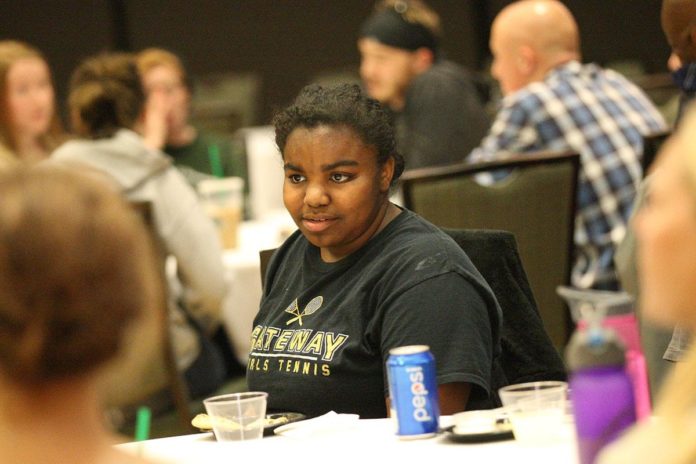Tuesday night in the Smith Center Ballroom, students and faculty gathered to take part is a discussion sponsored by the Diversity, Equity and Inclusion Leadership Team titled “Courageous Conversations.” The talk focused on how symbols have become a language, how these symbols affect our communication and interactions and why symbols are important.
“In order to know each other as a community, we need to be courageous and discuss [controversial symbols] at times,” SRU President Cheryl Norton said.
“We are surrounded by symbols in our culture,” committee member Dr. Brett Barnett said. We are exposed to symbols, like the American flag, from an early age and are taught what they mean. These meanings form into connotations, or associations, with the symbol.
“Generally, [symbols] are an object representing another to give it an entirely different meaning that is much deeper and more significant,” Barnett said.
Symbols are a crucial aspect to our language. In 1931, the Stromberg v California case extended the First Amendment to not only protect freedom of speech, but to protect symbolic speech. Symbols show diversity in how everybody views certain symbols differently. These views bring up ideas and talking about this helps us become more understanding.
Students discussed interpretations of the American flag; Americans are taught to be proud of our country and that the flag represents our freedom. However, it can be seen as a negative symbol to Native Americans, as the flag may be a reminder of how their native land was taken from them.
“You can’t be false in your opinion,” Barnett said.
Everyone’s opinion is valid, and every opinion is valued because without it, we couldn’t have these conversations in the first place, he said. Perspective on topics is what makes our language and symbols interesting.
Simple symbols can have such diverse meaning. For example, the Nike swoosh may be a symbol of exercise, motivation and style for some. For others, it may represent the unethical labor laws the company takes part in overseas.
“When some people see the Nike symbol they think of exercise,” Barnett said, “and when some people see the Nike symbol they talk about child labor laws.”
This emphasizes that there is always more to see than what just your eyes see, and there are multiple sides to every story.
One symbol that sparks debates is the Confederate flag.
“I feel negatively towards [the Confederate flag] because it is a bold representation of slavery,” Slippery Rock graduate student Ashley Craig said. “The origin of it is extremely negative. People are either uneducated about it because they want to be or they know flat-out that this is a symbol that offends a large population.”
People are just insensitive to how symbols like the Confederate flag can people feel, Slippery Rock student Kierstie Mapes said.
“When I see [the Confederate flag] I think of the Civil War and I think its and important topic,” Slippery Rock student Jess Lefler said.
“Many people do feel as if it’s a positive symbol but most of these people won’t mention it because they know it offends people,” Craig said. “Yes, it’s offensive, however, people are going to do what they do anyway, so you can’t let that ruin your shine.”
The committee emphasized that everyone has different perceptions, but that is not the issue. The issue is if we don’t learn to understand and talk about these differences, it can lead to hatred. We are all from different places, where we learn different things. Education and respect is what makes courageous conversations important rather than hateful.
“I just want people to be able to feel comfortable sharing thoughts on controversial topics,” committee staff member Corinne Gibson said.
Courageous conversations are how we learn, understand and educate, she said.








